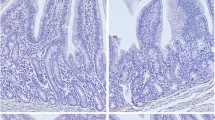Abstract.
In vitro and in situ findings suggest an impairment of digestive and absorptive functions in the small intestine by enteral cadmium salts. In the rat, diets with up to 1 mmol Cd/kg are well tolerated, however, so that the impairment might not be this drastic or compensated by adaptive changes. To elucidate whether small intestinal functions are altered, we studied the effect of dietary cadmium on the longitudinal pattern of mucosal enzymes and the in vitro uptake of methyl α-D-glucoside in the small intestine of female rats. Three groups of rats were employed, a control group and two groups receiving dietary CdCl2 either at 0.3 or 1.0 mmol Cd/kg of diet. Rats were killed after 1 week of feeding. The entire small intestine was removed, rinsed with ice-cold saline and divided into 12 segments of equal length. Mucosal scrapings from each segment were used to measure mucosal cadmium levels, sucrase, lactase, alkaline phosphatase, glycylleucine-hydrolase, and diamine oxidase activities. Sugar uptake was determined in vitro in all segments using everted rings tissue accumulation method. Although cadmium levels in the mucosa were high (>100 ng Cd/mg protein or >100 μmol Cd/kg WW) most enzyme activities were only slightly changed. When significant decreases in activity were detected, they were only observed in the proximal small intestine. Sugar uptake was also impaired only in proximal segments, the maximal transport capacity was reduced by approximately 20%. These findings suggest that cadmium even at dietary levels of 1 mmol/kg do not lead to a drastic impairment of digestive and absorptive functions in the small intestine and that in the rat presently observed, mostly proximal impairments are easily compensated by unaltered distal functions. Certainly, absorption of micronutrients, for which an impaired proximal function cannot be compensated, e.g. iron, might be critical in this respect.
Similar content being viewed by others
Author information
Authors and Affiliations
Additional information
Received: 27 July 1998/Accepted: 4 November 1998
Rights and permissions
About this article
Cite this article
Elsenhans, B., Hunder, G., Strugala, G. et al. Longitudinal Pattern of Enzymatic and Absorptive Functions in the Small Intestine of Rats After Short-Term Exposure to Dietary Cadmium Chloride. Arch. Environ. Contam. Toxicol. 36, 341–346 (1999). https://doi.org/10.1007/s002449900480
Issue Date:
DOI: https://doi.org/10.1007/s002449900480




